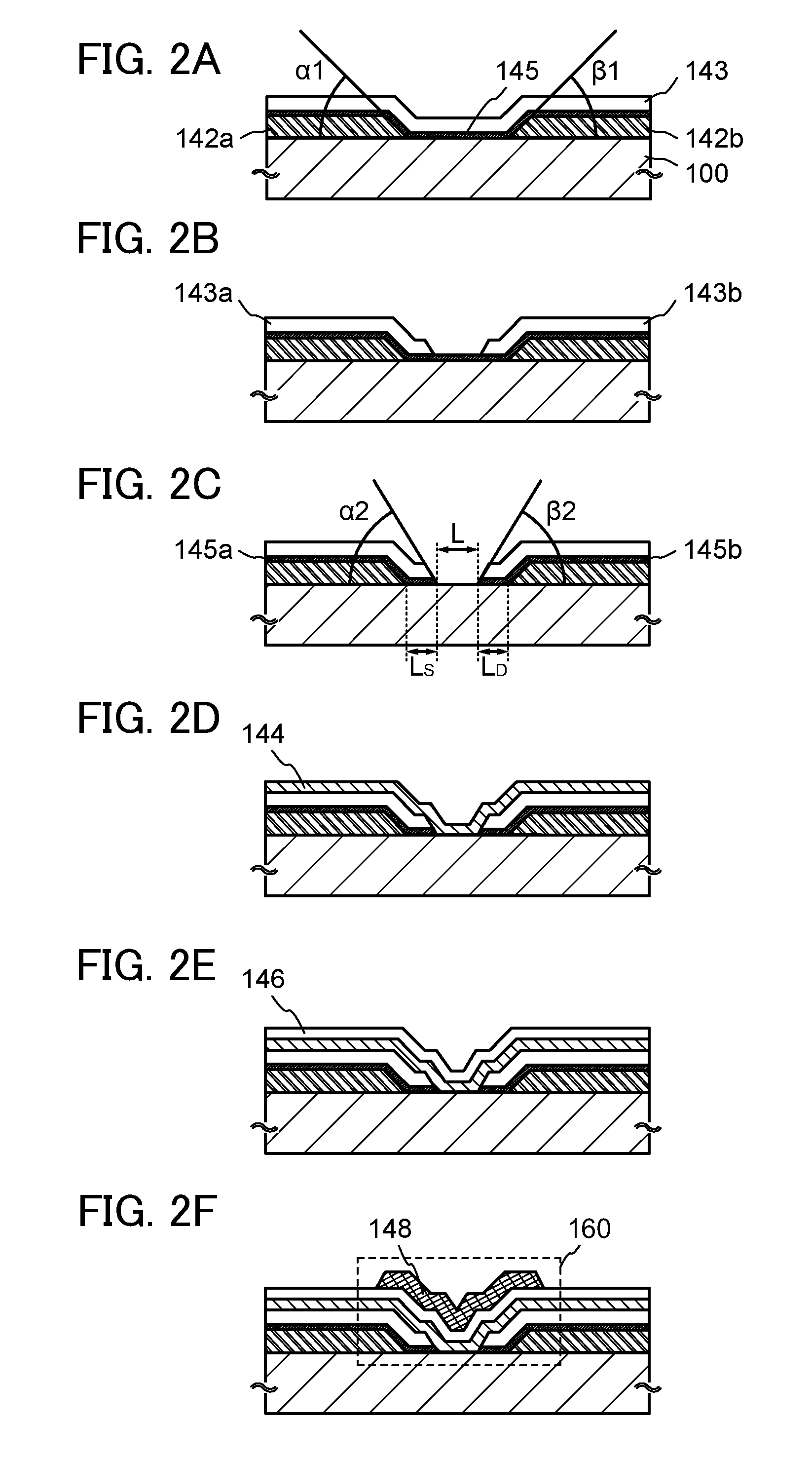Semiconductor device
a technology of semiconductors and devices, applied in the direction of semiconductor devices, basic electric elements, electrical appliances, etc., can solve the problems of short channel effect, poor connection, and major defect generation in manufacturing process, and achieve low power consumption, high speed operation, and cost reduction
- Summary
- Abstract
- Description
- Claims
- Application Information
AI Technical Summary
Benefits of technology
Problems solved by technology
Method used
Image
Examples
embodiment 1
[0057]In this embodiment, an example of a structure and a manufacturing process of a semiconductor device according to an embodiment of the disclosed invention will be described with reference to FIGS. 1A to 1D, FIGS. 2A to 2F, and FIGS. 3A to 3F.
[0058]In FIGS. 1A to 1D, as examples of semiconductor devices, cross-sectional structures of transistors are illustrated. In FIGS. 1A to 1D, top-gate transistors are illustrated as transistors according to one embodiment of the disclosed invention.
[0059]A transistor 160 illustrated in FIG. 1A includes, over a substrate 100, a source electrode in which a first conductive layer 142a and a second conductive layer 145a are stacked in this order; a drain electrode in which a first conductive layer 142b and a second conductive layer 145b are stacked in this order; an insulating layer 143a provided over the source electrode; an insulating layer 143b provided over the drain electrode; an oxide semiconductor layer 144 provided over the insulating la...
embodiment 2
[0129]In this embodiment, a structure and a manufacturing process of a semiconductor device according to one embodiment of the disclosed invention, which are different from those of Embodiment 1, will be described with reference to FIG. 4 and FIGS. 5A to 5F.
[0130]A transistor 280 illustrated in FIG. 4 is an example of a structure of a semiconductor device. The order of stacking of the transistor 280 corresponds to that of the transistor 180 illustrated in FIG. 1C. The difference between the transistor 280 and the transistor 180 is that a sidewall insulating layer 252a is provided over the second conductive layer 245a in a region which extends in a channel length direction from an end portion of the first conductive layer 242a and a sidewall insulating layer 252b is provided over the second conductive layer 245b in a region which extends in a channel length direction from an end portion of the first conductive layer 242b.
[0131]The transistor 280 illustrated in FIG. 4 includes, over ...
embodiment 3
[0159]In this embodiment, application examples of a semiconductor device according to one embodiment of the disclosed invention will be described with reference to FIGS. 6A-1, 6A-2, and 6B. Here, an example of a memory device will be described. Note that in a circuit diagram, “OS” is written in order to indicate that a transistor includes an oxide semiconductor.
[0160]In the semiconductor device illustrated in FIG. 6A-1, a first wiring (a 1st line) is electrically connected to a source electrode of a transistor 300. A second wiring (a 2nd line) is electrically connected to a drain electrode of the transistor 300. Further, a third wiring (a 3rd line) is electrically connected to one of a source electrode and a drain electrode of a transistor 310, and a fourth wiring (4th Line) is electrically connected to a gate electrode of the transistor 310. A gate electrode of the transistor 300 and the other of the source electrode and the drain electrode of the transistor 310 are electrically co...
PUM
 Login to View More
Login to View More Abstract
Description
Claims
Application Information
 Login to View More
Login to View More - R&D
- Intellectual Property
- Life Sciences
- Materials
- Tech Scout
- Unparalleled Data Quality
- Higher Quality Content
- 60% Fewer Hallucinations
Browse by: Latest US Patents, China's latest patents, Technical Efficacy Thesaurus, Application Domain, Technology Topic, Popular Technical Reports.
© 2025 PatSnap. All rights reserved.Legal|Privacy policy|Modern Slavery Act Transparency Statement|Sitemap|About US| Contact US: help@patsnap.com



